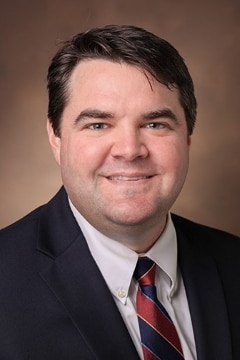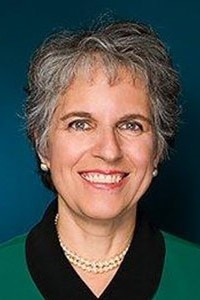Commendations & Commencements
Welcome

Dr. W. Stuart Reynolds joined NIDDK last year as a program director within the Division of Kidney, Urologic, and Hematologic Diseases, overseeing clinical and translational research in women’s urology. Prior to joining NIDDK, Reynolds was an associate professor of urology at Vanderbilt University Medical Center with clinical expertise in neurourology and urogynecology and reconstructive pelvic surgery. He was also primary researcher for Vanderbilt’s Urinary Reconstruction, Incontinence, and Neurourology (U.R.I.Ne.) Lab, which works to improve the understanding and management of functional urinary disorders and lower urinary tract dysfunction, including overactive bladder syndrome, urinary incontinence, and neurogenic lower urinary tract dysfunction.

Dr. Stefania Senger joined the Division of Digestive Diseases and Nutrition last year as a program officer and will manage a portfolio focused on basic epithelial biology and diseases and conditions involving the alimentary gastrointestinal tract. Prior to joining NIDDK, Dr. Senger worked at the Center for Scientific Review where she oversaw reviews associated with the cellular, molecular, and immune aspects of lung biology.
Congratulations


Dr. Joel Habener and Dr. Svetlana Mojsov, both NIDDK grant recipients, won the 2024 Lasker-DeBakey Clinical Medical Research Award for their role in the discovery and development of glucagon-like peptide-1 (GLP-1) drugs that have revolutionized treatments for diabetes and obesity and have the potential to dramatically enhance health.
They share this prize with fellow researcher Lotte Bjerre Knudsen, of Novo Nordisk. Their collective efforts have led to the design of groundbreaking new pharmaceuticals and to a new era of medical science.
A leader in the fields of diabetes and endocrinology, Dr. Habener has been researching the role of the hormone glucagon in blood sugar regulation since the 1970s, and NIDDK has been supporting his work for nearly 40 years. NIDDK also funded Dr. Mojsov's research on GLPs in the 1980s and 1990s.

Dr. Jenny E. Hinshaw, section chief of the Structural Cell Biology Section in the Laboratory of Cell & Molecular Biology, has been appointed chief of the Laboratory of Molecular Biology (LMB), which unites geneticists, biochemists, developmental biologists, physical chemists, and structural biologists to study topics ranging from retroviral integration to single molecule microscopy. Serving as LMB chief since 2014, Dr. Susan Buchanan will be stepping down from the position and remain as a senior investigator.
Fond Farewell

Kathy Kranzfelder, director of NIDDK’s Office of Communications and Public Liaison (OCPL) for the past 15 years, retired after more than three decades of service to NIH. Kranzfelder built a reputation across NIH as a nuanced writer, keen editor, and straightforward communicator. Her NIDDK legacy includes reorganizing OCPL and streamlining overlapping contracts and programs to save millions of dollars while elevating NIDDK’s brand. Over the 20 years preceding her role as communications director, she was director of NIDDK’s congressionally authorized health information clearinghouses and press team lead for NIDDK’s Division of Intramural Research. She recruited colleagues to help her build NIDDK’s website in 1994, which was the first website among NIH’s Institutes and Centers (ICs), and founded the Web Authors Group—the prototype for cross-IC communications about web operations. Kranzfelder began her career at NIH in 1987, covering intramural science for the National Institute of Neurological Disorders and Stroke.

Dr. Brian Oliver has retired from NIDDK after serving as chief of the Section of Developmental Genomics for 29 years. Since joining NIDDK, Oliver sought to explore and predict how genes collectively work together to influence development and disease susceptibility via the model organism Drosophila melanogaster. In pursuit of his goal, he developed machine-learning models to predict D. melanogaster gene expression to understand how subtle perturbations to gene networks influence inherited disease susceptibility. Working together with extramural and NIDDK investigators, he helped construct the Fly Cell Atlas, uncovered mechanisms of sex chromosome expression in Drosophila germ cells, and mapped the dynamics of adult Drosophila stem cell lineages. Oliver contributed globally to studies using model organisms by serving on advisory boards of FlyBase and the pan organismal Alliance of Genomic Resources. He served as the Chief Science Officer of Precision Toxicology, a European Commission-funded project to use the comparative genomics of gene expression, metabolomics, and phenotype to identify toxicological pathways, and he was awarded the NIH Director’s Challenge Innovation award for “Machine Vision-enabled behavioral tracking for cross species extrapolation.”

Dr. Susan Z. Yanovski, co-director of the NIDDK Office of Obesity Research, retired after decades of service to NIDDK. Yanovski first joined NIH’s National Institute of Mental Health as an intramural research fellow, where she participated in studies to characterize binge eating disorder and co-authored the seminal papers leading to its inclusion in the Diagnostic and Statistical Manual of Mental Disorders, 4th Edition as a new category of eating disorder. The screening instrument she co-developed has been included in the NIH PhenX toolkit as a valid and reliable measure and has been translated into multiple languages.
Her work at NIDDK over the past 32 years has focused on behavioral, medical, and surgical approaches to obesity treatment, and she has been instrumental in developing some of the NIH’s most consequential clinical trials, including Look AHEAD, the Longitudinal Assessment of Bariatric Surgery (LABS), and the Lifestyle Intervention for Expectant Moms (LIFE-Moms) study. Dr. Yanovski has led numerous working groups at the NIH and in public-private partnerships, including on the Senior Leadership Group of the NIH Obesity Research Task Force, as co-lead of the National Collaborative on Childhood Obesity Research Engaging Health Care Providers and Systems Work Group, and more. Her work to advocate for the respectful treatment of people living with obesity will leave a lasting impact across the NIH.
In Memoriam

Dr. Bruce Ames died in October at the age of 95. Ames worked at NIH from 1953 to 1967, first as a postdoc, then as a biochemist, and then as chief of the Microbial Genetics Section in the Laboratory of Molecular Biology, in what is now NIDDK. He famously created the Ames test, a widely used tool to determine the mutagenic potential of chemical compounds. Read more in the NIH Record: NIH Remembers Ames.

